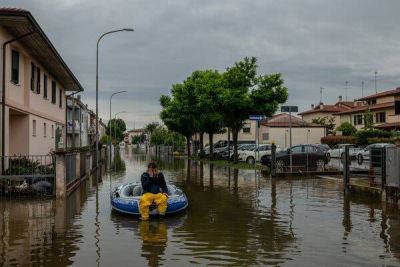After floods devastated much of the northeastern Emilia Romagna region last month, researchers said that climate change was not the only factor behind the "rare" event. After three cyclones hit the northern Italian region in mid-May, a team of researchers used computer simulations and past observations to investigate whether human-caused climate change was directly responsible, but found things were more complex than that. Seventeen people died and tens of thousands were forced to leave their homes after three exceptionally heavy downpours hit the Emilia Romagna region within three weeks, causing landslides and floods that destroyed farmland, towns and businesses. The World Weather Attribution (WWA) said May had seen "the wettest event of this type" for two centuries. Their study estimated there was a 1-in-200 chance that three cyclones would strike within a three-week period, and the team cautioned that this exceptional event meant more time for research was needed. The group, whose goal is to demonstrate reliable links between global warming and certain weather phenomena, said its models suggest such events, in this region at this time of year, are not becoming more frequent or intense. "It is relatively unusual for an attribution study to find that extreme rainfall was not made more likely by greenhouse gas emissions," the WWA said in a press statement. "Our statistical findings acknowledge the uniqueness of such an event which was driven by an unprecedented sequence of three low-pressure systems in the central Mediterranean," said Davide Faranda, a researcher in climate physics at the Pierre-Simon Laplace Institute in France. He emphasized that it was not that climate change had no role, but the relationship went beyond the organization’s statistical analyses. "Although spring heavy rainfall episodes are not increasing in Emilia Romagna, extreme rainfall is increasing in other parts of Italy," he said. Almost 94 percent of Italian municipalities are at risk of landslides, floods and coastal erosion, according to the Italian Institute for Environmental Protection and Research (ISPRA). Emilia Romagna is particularly at risk, with a history of flooding and landslides, although nothing even comparable to this month's disaster has occurred since 1939, said the study.
Il mese scorso, molte inondazioni hanno distrutto quasi tutta la parte nord est dell'Emilia Romagna. Gli scienziati non sanno se le inondazioni siano attribuite solo al cambiamento climatico e/o alle azioni degli umani. La regione ha avuto tre tornado e le peggiori tempeste degli ultimi due secoli. Diciassette persone sono morte e decine di migliaia hanno dovuto lasciare le loro case. Dopo tre settimane di pioggia continua, frane e inondazioni hanno rovinato terreni agricoli, villaggi, città e agenzie. L'agenzia World Weather Attribution ha affermato che non ha mai indagato una catastrofe come questa. Ha anche affermato che la possibilità della quantità di pioggia e tornado in tre settimane sarebbe piccola. L'agenzia ha anche scritto che c’è bisogno di dedicare più tempo alla ricerca dei motivi per questi cambi meteorologici. L'agenzia fa la ricerca sull'effetto serra e meteorologico in tutto il mondo. Ritiene che gli eventi in Emilia Romagna sono rari e non la nuova normalità. In un comunicato stampa, l'agenzia ha affermato che la situazione in Emilia Romagna non è correlata ai gas serra. Invece, ha scritto che le tempeste e la quantità di pioggia sono conseguenza dei sistemi di bassa pressione nel Mar Mediterraneo. Secondo Davide Farando, scienziato in fisica del clima all'Istituto Pierre-Simon Laplace in Francia, non ritiene che ci sia un legame tra l'effetto serra e le inondazioni, ma ritiene il fenomeno più legato alle precipitazioni estreme in tutta Italia. Secondo l'Istituto Italiano per la Protezione Ambientale, quasi il 94% dell'Italia è a rischio frane, inondazioni, ed erosione. L'Emilia Romagna è a rischio più di altre regioni perché ha una storia di inondazioni e frane anche se gli eventi di maggio erano rari.



